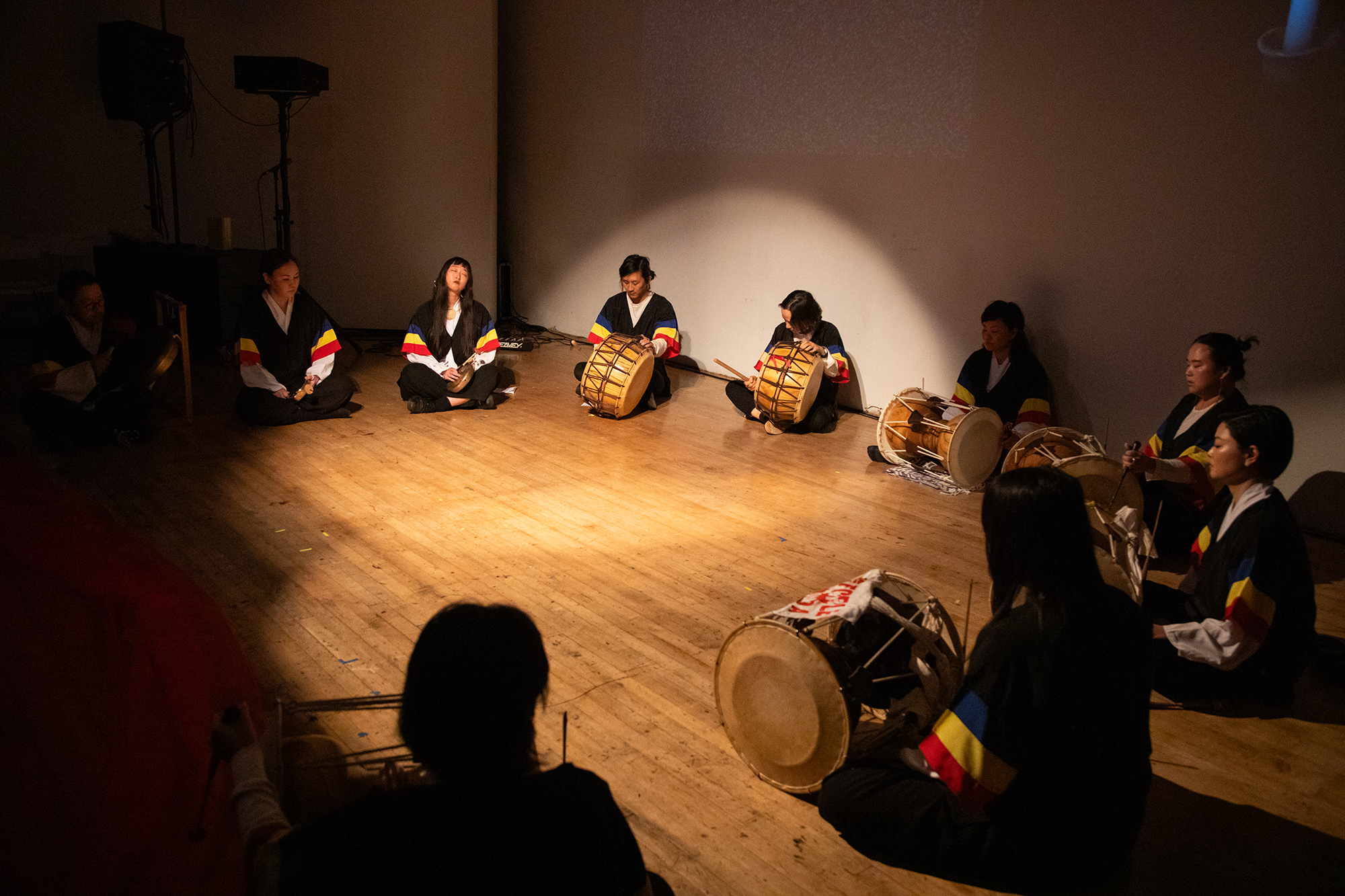Guest blog written by Roger Kim, Interdisciplinary Artist and Artist in resident at ARTogether Studios
In 2022, I invited a few people to meet me at Lake Merritt on Thursday mornings so I could teach them samulnori, a traditional Korean percussion practice. At the time I didn’t even have a complete set of instruments, the threat of rain often cancelled our meetings, and my experience with teaching private music lessons to busy adults had led me not to expect this venture to last very long, and despite my best efforts to create a welcoming environment I fully expected that things would fizzle out and I would be spending Thursday mornings drumming by myself within a few months. Fortunately I was wrong. Three years later we are still meeting weekly and performing throughout the Bay Area, as Kkiri Kkiri Samulnori

When I first started studying traditional Korean music I thought it could teach me “Koreanness.” In hindsight, it is ridiculous to think that there is a singular of “Koreanness” that could explain everything Korean, and that I would find it in traditional music that very few people seriously practiced or even listened to anymore. I realized much later that what I was actually seeking was belonging.
I sense the same from the members of Kkiri Kkiri. They join to learn traditional Korean drumming of course, but I don’t think that dedication to music is the main reason Kkiri Kkiri has lasted beyond its first few precarious months. Kkiri Kkiri rehearsals have become a place to talk about our experiences as Koreans, Korean-Americans, mixed race Koreans, and adoptees. Members check in with each other, celebrate each other’s life events, and become a part of one another’s lives — all within the shared context of being Korean in some way and wanting to learn more about Korea. Early on, we voted to limit Kkiri Kkiri’s membership to people with Korean heritage. Even though it went against my initial impulse that anyone should be able to join, I knew that there just aren’t enough spaces for Koreans to gather in community.

The seeking of tradition has become a fascinating phenomenon to me. I strongly suspect that the diasporic seeking of traditional things is really a seeking of belonging. My interest in traditional Korean music very quickly connected me with others in the Korean diaspora, even when it was still only an interest. It also sparked a broader interest in Korean history, and its effects on modern Korean politics, Korean immigration, and the diasporic experience; which in turn connected me to even more people within the Korean diaspora. There are so many diasporic Koreans with similar interests — especially traditional practice — that it is a bit of a cliche, but I think it speaks to larger forces in the diaspora, feelings of alienation and unrootedness, that push us onto similar trajectories.
In my work as an artist, I often think about the diaspora’s relationship to traditional practices. My piece robo gayageum, is a stringed instrument based on the traditional Korean gayageum, but fitted with motors that pluck and push on the strings. The gayageum is one of the traditional instruments that I learned in Korea, but I found the learning curve such that I could not share it the same way that I share samulnori. By fitting the gayageum with motors, I make it easy to play by pushing buttons, interacting with sensors, or making hand gestures. Robo gayageum is the adaptation of tradition to serve diasporic needs. It is accessible in a way that invites participation and more opportunities for connection.

When I first started teaching Kkiri Kkiri, I felt timid, as if I was daring to shoulder one of Korea’s important legacies without being properly qualified. Though I had traveled to Korea to take classes and lessons, I knew that I could not teach in a way that was completely faithful to the way my own teachers had learned and taught. I would be apologetic when I was unsure about a technique, or for having gaps in my knowledge in certain pieces. The strength of Kkiri Kkiri’s community, however, made me realize that we were building our own legacies in our pocket of the diaspora, and that it could be ok to be generative in our practice of tradition. I realized we could be less strict about technique since what we really wanted was to get more people playing together quickly. Likewise compositions and arrangement could change and grow to suit our growing abilities and our tastes. Our Koreanness is rooted in our shared history and culture, expressed uniquely due to our different circumstances. The samulnori of Kkiri Kkiri is the same, rooted in the knowledge passed to us from Korea and adapted for the needs of our community and the way we want to practice.
Robo Gayageum Performance at Marin Headlands

Bio:
Roger Kim is an interdisciplinary artist whose work explores the relationships between diaspora, tradition, trauma, and belonging. Roger studied music and art at UC Berkeley, California Institute of the Arts, and Skowhegan School of Painting and Sculpture, and traditional Korean music with Ji Soonja, Scarlett Choi, Kim Dongwon, and Moon Soohyun in South Korea. He has received recognition and support from Vermont Studio Center, ICA San Francisco, Broken Pencil Magazine, YBCA New Frequencies Festival, CultureHub LA, and San Francisco Contemporary Music Players. Roger publishes puri zine about Korean history, is the founder of Kkiri Kkiri Samulnori, and performs with Hwa Records collective.
Contact information
https://www.instagram.com/rodgepodgemusic
https://www.instagram.com/kkiri.kkiri.samulnori
https://www.instagram.com/purizine
https://www.instagram.com/hwarecords/

